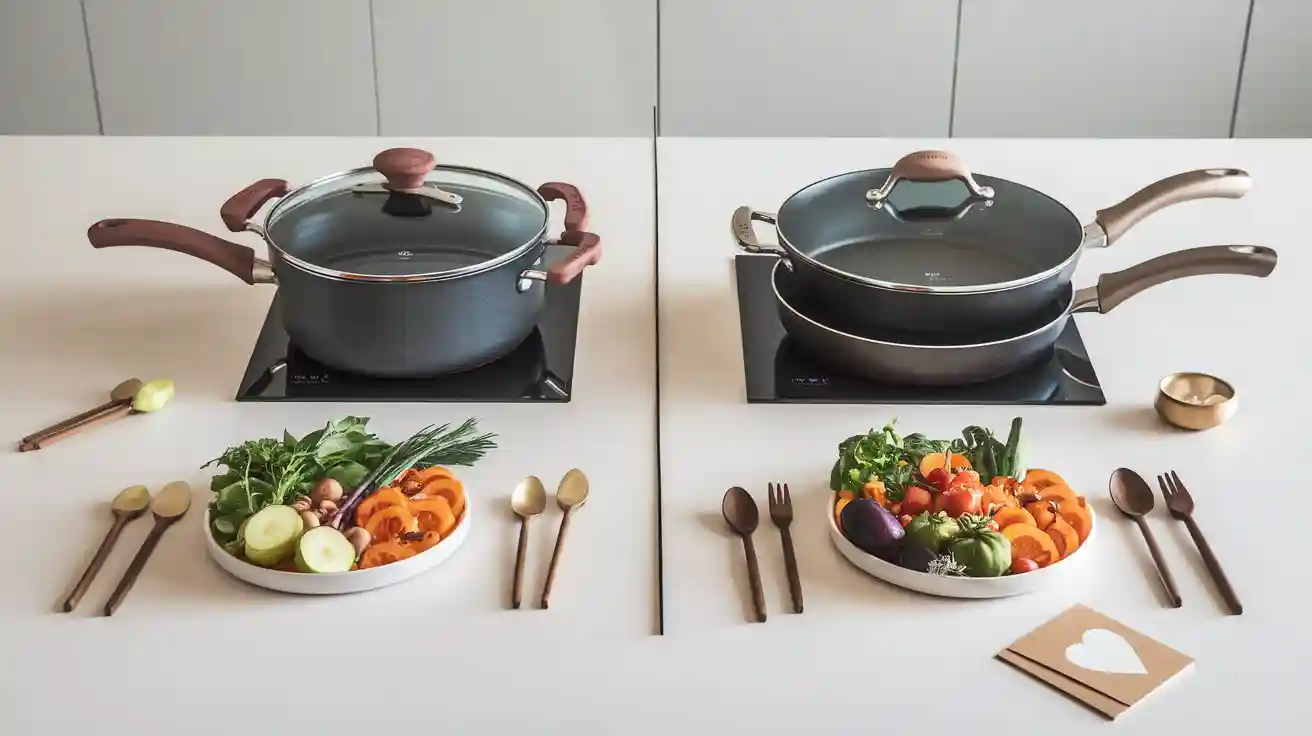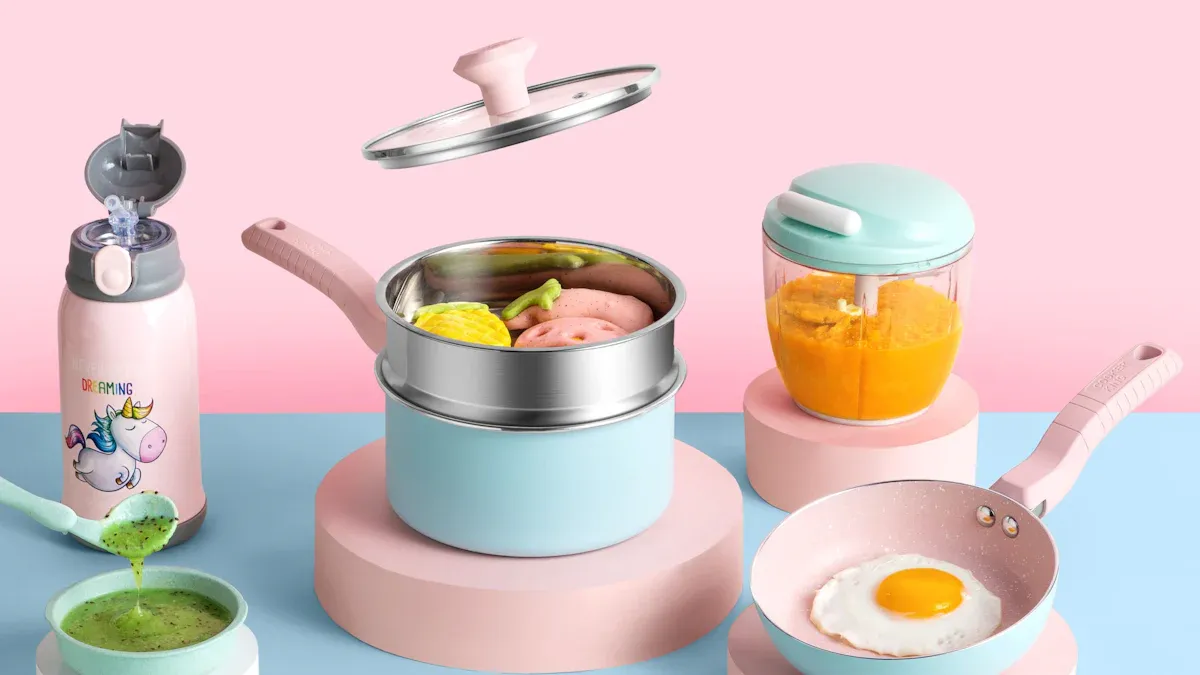
When you compare ceramic cookware sets to non-stick cookware, you find key health and safety differences. Ceramic cookware often uses natural materials and avoids harmful chemicals. The table below shows why ceramic vs. nonstick cookware matters for your health and eco-friendliness.
| Aspect | Ceramic Cookware | Nonstick Cookware |
|---|---|---|
| Health Risks | Non-toxic | Linked to PFAS exposure |
| Durability | Long-lasting | Coating degrades |
| Environmental Impact | Eco-friendly | Persistent chemicals |
Ceramic Cookware Sets: Health and Safety Overview
What Is Ceramic Cookware?
When you look at ceramic cookware sets, you find two main types. Some pieces use a metal core with a ceramic nonstick coating. Others are 100% ceramic cookware, made only from pure ceramic materials. Both types give you non-toxic options for your kitchen. Ceramic nonstick pans and pots help you cook with less oil and make cleanup easy. Many people choose ceramic cookware because it offers health benefits and avoids harmful chemicals.
Materials and Manufacturing Process
Ceramic cookware uses different materials based on the type. You can see the differences in the table below:
| Type of Ceramic Cookware | Materials Used | Durability and Food Safety Impact |
|---|---|---|
| Ceramic-Coated Cookware | Metal core (usually aluminum, sometimes cast iron or stainless steel) with a ceramic coating containing ceramic materials and silica (sol-gel coating) | Coating is less durable, can chip or degrade at high temperatures, potentially exposing metal core. If core is stainless steel, exposure is not harmful. Not dishwasher or high-heat safe. |
| 100% Ceramic Cookware | Pure ceramic materials such as fireclay, natural minerals, and oxides, fired at high temperatures; sealed with a ceramic glaze | Highly durable, non-toxic, bacteria-resistant, does not chip or degrade under high heat, dishwasher safe, and does not leach harmful chemicals. |
You should always buy ceramic cookware sets from trusted brands. The FDA checks for leachable lead and cadmium in ceramic products. This keeps your food safe. Damaged, antique, or handmade ceramic cookware may contain lead or cadmium, so avoid using them for cooking.
Health and Eco-Friendliness of Ceramic Cookware
Ceramic cookware sets stand out as non-toxic cookware. Pure ceramic cookware does not release harmful chemicals, even at high temperatures. Ceramic nonstick coatings are usually free from PFAS and other pollutants. You get a safer choice for your health and the environment. Scientific studies show that ceramic nonstick coatings resist heat better than PTFE coatings. PTFE can break down and release toxins, but ceramic nonstick avoids this risk. When you choose 100% ceramic cookware, you support health and eco-friendliness in your kitchen. Always look for labels that say “fluorine-free” to make sure you get non-toxic cookware.
Tip: Choose pure ceramic cookware or ceramic-coated cookware from reputable brands for the best safety and non-toxic cooking.
Traditional Nonstick Cookware: Safety and Health Concerns
PTFE, PFOA, and Other Nonstick Coatings
When you use traditional nonstick cookware, you often rely on coatings made from PTFE, also known as Teflon. PTFE gives non-stick cookware its smooth, easy-release surface. For many years, manufacturers used PFOA, a type of PFAS, to make these coatings. Due to health concerns, companies have phased out PFOA since 2013. However, PTFE remains the main material in most nonstick cookware today. PFAS chemicals, including PFOA, do not break down easily. They can build up in your body and the environment. This raises concerns about long-term exposure to toxins.
Note: PTFE particles that flake off during cooking are not harmful if swallowed. They pass through your digestive system without causing damage.
You see a shift in the market toward PFOA-free and non-toxic nonstick options. Still, traditional non-stick cookware with PTFE dominates because of its performance. Many brands now advertise non-toxic nonstick coatings, but you should always check labels for PFAS content.
Chemical Exposure and Off-Gassing Risks
Traditional nonstick cookware can release toxic fumes when overheated. If you heat a PTFE-coated pan above 500°F (260°C), the coating starts to break down. This process releases PFAS chemicals and other toxins into the air. Breathing these fumes can cause polymer fume fever, also called Teflon flu. You might feel chills, headaches, muscle aches, or even have trouble breathing. These fumes are especially dangerous for pet birds.
Studies show that even at normal cooking temperatures, nonstick cookware can emit small amounts of PFOA and other PFAS. As your pans age or the coating wears down, the risk of chemical exposure increases. PFAS chemicals stay in the environment and your body for a long time. To protect your health and safety, always use non-toxic nonstick cookware below high heat, avoid preheating empty pans, and replace worn-out cookware.
Ceramic vs. Nonstick Cookware: Side-by-Side Health Comparison

Chemical Leaching and Toxicity
When you compare ceramic cookware and nonstick cookware, you want to know what might get into your food. Chemical leaching means chemicals move from the pan into your meal. With traditional nonstick cookware, older pans used PFOA, a chemical now known to be harmful. Modern nonstick cookware uses PTFE, which does not cause harm if you swallow small flakes. However, when you overheat these pans, PTFE can break down and release fumes that may be toxic if you breathe them in.
Ceramic cookware sets use a sol-gel coating that is free from PTFE and PFOA. This makes ceramic nonstick cookware a non-toxic choice for your kitchen. Still, ceramic coatings are a newer technology, and scientists have not studied them as much. Some ceramic-coated cookware may contain metal nanoparticles, but there is no strong evidence that these cause health problems under normal use.
You should also know that some low-quality ceramic cookware may have leachable lead and cadmium in the glaze. These metals can be harmful if they get into your food. Always choose high-quality ceramic cookware from trusted brands to avoid this risk.
- Possible health implications from chemical leaching:
- Older nonstick pans may have contained PFOA, now removed due to health risks.
- Modern nonstick cookware uses PTFE, which is safe if ingested but can release toxic fumes when overheated.
- Chemicals like GenX, used to replace PFOA, have unknown health effects.
- Ceramic nonstick coatings are PTFE-free and may be healthier, but long-term health data is limited.
- Metal leaching from stainless steel, cast iron, or aluminum is minimal and not a health risk.
- Ingesting chemicals from cookware under normal use has no proven direct toxicity, but inhaling fumes from overheated PTFE is a concern.
Tip: Always check for labels that say “lead-free” and “cadmium-free” when you buy ceramic cookware.
High-Temperature Safety
You need to know how your cookware reacts to heat. Ceramic cookware can handle higher temperatures than non-stick cookware. Ceramic nonstick pans do not break down or release harmful substances when you use them for high-heat cooking. This makes ceramic cookware a safer choice if you like to sear or roast food at high temperatures.
Nonstick cookware with PTFE coatings starts to break down above 500°F (260°C). When this happens, the pan can release fumes that may cause “Teflon flu” or polymer fume fever. This is rare in home kitchens but can happen if you leave a pan empty on a hot burner. Ingesting small flakes of nonstick coating is not harmful, but breathing in fumes from overheated pans can be dangerous, especially for pet birds.
Here is a quick look at safe temperature thresholds:
| Cookware Type | Safe Temperature Thresholds | Additional Safety Notes |
|---|---|---|
| Ceramic Coated Cookware | Recommended not to exceed 500°F (260°C) | Heat resistant up to ~842°F (450°C) theoretically; avoid sudden temperature changes to prevent cracking. |
| Nonstick (PTFE/Teflon) | Breakdown and toxic fumes start above 500°F | Emits toxic fumes above 500°F; can cause ‘teflon flu’; unsafe for pet birds. |
| Oven Use (Stainless Steel Handles) | Safe up to 500°F | Depends on handle material; stainless steel handles tolerate higher oven temperatures. |
| Oven Use (Silicone Handles) | Safe up to 350°F | Silicone handles have lower heat tolerance in oven use. |
Ceramic cookware is also resistant to scratching and does not emit harmful fumes when heated. You should heat ceramic nonstick pans slowly and avoid sudden temperature changes, like putting a hot pan in cold water, to keep them in good shape.
Durability and Longevity
When you invest in cookware, you want it to last. Ceramic cookware and nonstick cookware both have limits on how long they stay nonstick and safe. Nonstick cookware usually lasts about five years. Premium nonstick pans can last up to ten years if you take good care of them, but most coatings wear off much sooner.
Ceramic cookware, especially ceramic-coated pans, tends to have a shorter lifespan. Most ceramic nonstick pans last less than five years. The coating can be more brittle and may scratch or wear out faster than traditional nonstick cookware. Even though some brands claim their ceramic nonstick pans last longer, you may need to replace them more often.
- Ceramic cookware is less durable than nonstick cookware when it comes to scratches and wear.
- Both types lose their nonstick properties over time, but ceramic coatings usually degrade faster.
- Premium ceramic-coated cookware, like some GreenPan products, can last several years with gentle use.
Note: To make your cookware last longer, use wooden or silicone utensils and avoid harsh scrubbing.
Ceramic vs. nonstick cookware both offer benefits and drawbacks for health and safety. You need to weigh the risks of chemical leaching, high-temperature safety, and how long each type will last in your kitchen.
Usage, Care, and Maintenance for Safety
Best Practices for Ceramic Cookware
You can keep your ceramic cookware in great shape by following a few simple steps. Always cook on low to medium heat. High heat can damage the ceramic nonstick layer and shorten the life of your pans. Use wooden, silicone, or nylon utensils. Metal tools can scratch the surface and make your cookware less effective.
When cleaning, hand wash your ceramic cookware with mild soap and a soft sponge. Dishwashers and abrasive scrubbers can wear down the coating. For tough stains, try a paste of baking soda and water or soak the pan in warm water. Dry your cookware right after washing to prevent mineral spots.
Store your pans with care. Place a soft liner or towel between stacked pans to avoid scratches. Hanging your cookware or using a rack also helps protect the surface. Always match the pan size to the burner for even cooking and to avoid hot spots. Never heat an empty pan; add oil, water, or food before turning on the stove.
Tip: Using high-quality oils or butter can help prevent sticking and make cleaning easier.
Safe Use of Nonstick Cookware
You can use nonstick cookware safely by following a few important guidelines. Avoid cooking on high heat. High temperatures can cause traditional nonstick cookware to release harmful chemicals like PFAS. Stick to low or medium heat for most recipes.
Choose wooden or silicone utensils to protect the nonstick coating. Metal utensils can scratch the surface and increase the risk of chemical release. Clean your nonstick cookware after each use with a soft sponge and gentle soap. Avoid harsh cleaners and never use abrasive pads.
Replace your nonstick cookware every two to three years, or sooner if you notice scratches or peeling. Damaged pans can pose health risks. Do not store food in nonstick pans, and always transfer leftovers to glass or ceramic containers. If you want a safer option, consider switching to ceramic nonstick or stainless steel cookware.
Note: Always check for signs of wear and replace pans as needed to keep your kitchen safe.
Choosing the Healthiest and Safest Cookware
Key Factors to Consider
When you choose cookware for your kitchen, you want to keep your health and safety in mind. Look at these important factors:
- Cookware materials matter. Pick options that do not leach toxic chemicals. Ceramic cookware, stainless steel, and cast iron are safe choices. Avoid pans with PTFE and PFOA, which can release harmful fumes.
- Durability helps you save money over time. Stainless steel and cast iron can last for many years if you care for them. Most nonstick pans wear out faster.
- Think about your cooking needs. If you cook often, invest in a few high-quality pieces. For small kitchens, choose versatile cookware that works for many recipes.
- Price is important. Sometimes, spending more on durable, non-toxic options saves you money in the long run. You can also find safe cookware at reasonable prices.
- Brand reputation and third-party safety certifications help you trust your purchase. Brands like Caraway and Xtrema share test results and meet strict safety standards.
Tip: Look for cookware with third-party certifications to make sure you get non-toxic options.
Practical Tips for Health and Eco-Friendliness
You can make smart choices for your health and the planet with these steps:
- Choose cookware made from non-toxic, sustainable materials like ceramic cookware, stainless steel, or cast iron.
- Avoid products with PTFE, PFOA, or cadmium.
- Buy only what you need. Pick versatile pieces that save space and energy.
- Care for your cookware by hand washing and storing it properly. This helps it last longer.
- Donate or reuse old cookware. If you cannot reuse it, check if a scrap metal center or mail-back program will recycle it.
Remember: Reusing or donating old ceramic cookware is the most eco-friendly way to dispose of it.
- Ceramic cookware is non-toxic, free from PFAS, and safer at high heat than traditional nonstick pans.
- Nonstick pans require careful use to avoid fumes and scratches.
- Choose ceramic if you want fewer chemicals. Always check labels and care instructions.
Choosing eco-friendly cookware helps protect your health and the environment.
FAQ
Can you use metal utensils on ceramic cookware?
You should not use metal utensils. Metal can scratch the ceramic surface. Choose wooden, silicone, or nylon tools to protect your pans.
Is ceramic cookware dishwasher safe?
Most ceramic cookware is dishwasher safe. Hand washing helps your pans last longer. Always check the manufacturer’s instructions before cleaning.
Do nonstick pans release toxins at low heat?
Nonstick pans do not release toxins at low heat. Toxic fumes only form when you overheat the pan above 500°F. Always cook on low or medium heat.


